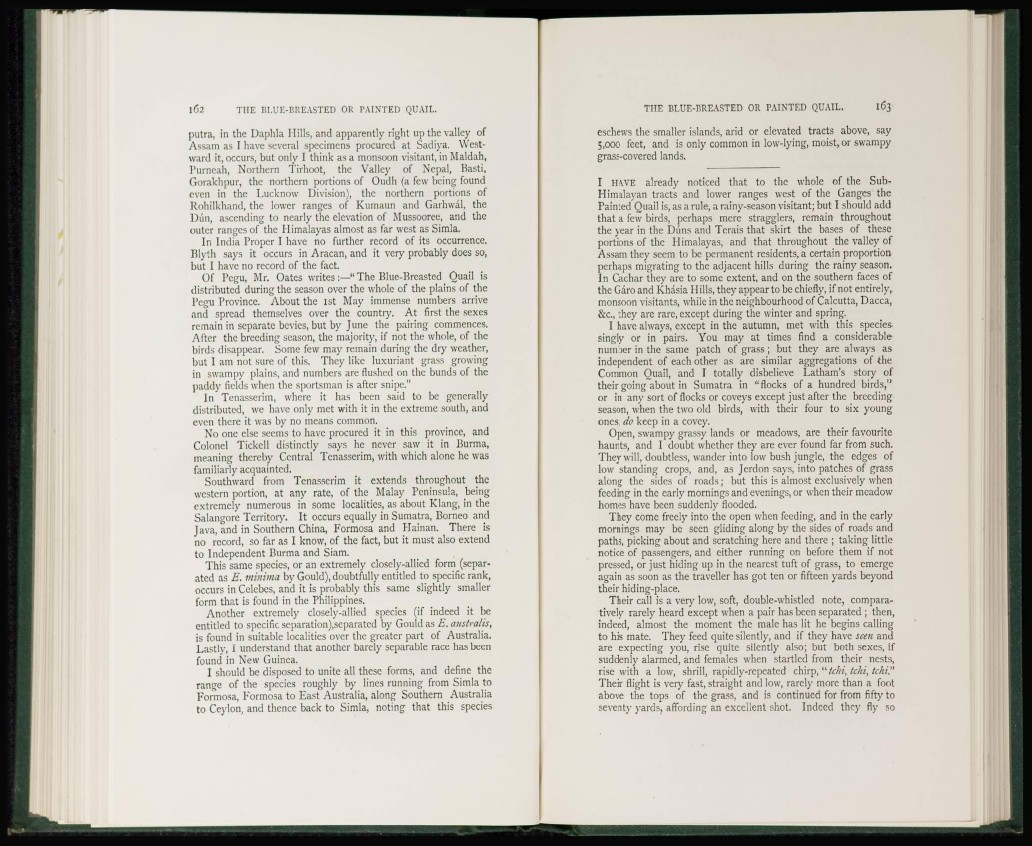
putra, in the Daphla Hills, and apparently right up the valley of
Assam as I have several specimens procured at Sadiya. Westward
it, occurs, but only I think as a monsoon visitant, in Maldah,
Purncah, Northern Tirhoot, the Valley of Nepal, Basti,
Gorakhpur, the northern portions of Oudh (a few being found
even in the Lucknow Division), the northern portions of
Rohilkhand, the lower ranges of Kumaun and Garhwal, the
Dun, ascending to nearly the elevation of Mussooree, and the
outer ranges of the Himalayas almost as far west as Simla.
In India Proper I have no further record of its occurrence.
Blyth says it occurs in Aracan, and it very probably does so,
but I have no record of the fact.
Of Pegu, Mr. Oates writes:—"The Blue-Breasted Quail is
distributed during the season over the whole of the plains of the
Pegu Province. About the 1st May immense numbers arrive
and spread themselves over the country. At first the sexes
remain in separate bevies, but by June the pairing commences.
After the breeding season, the majority, if not the whole, of the
birds disappear. Some few may remain during the dry weather,
but I am not sure of this. They like luxuriant grass growing
in swampy plains, and numbers are flushed on the bunds of the
paddy fields when the sportsman is after snipe."
In Tcnasscrim, where it has been said to be generally
distributed, we have only met with it in the extreme south, and
even there it was by no means common.
No one else seems to have procured it in this province, and
Colonel Tickell distinctly says he never saw it in Burma,
meaning thereby Central Tcnasscrim, with which alone he was
familiarly acquainted.
Southward from Tenasserim it extends throughout the
western portion, at any rate, of the Malay Peninsula, being
extremely numerous in some localities, as about Klang, in the
Salangorc Territory. It occurs equally in Sumatra, Borneo and
Java, and in Southern China, Formosa and Hainan. There is
no record, so far as I know, of the fact, but it must also extend
to Independent Burma and Siam.
This same species, or an extremely closely-allied form (separated
as E. minima by Gould), doubtfully entitled to specific rank,
occurs in Celebes, and it is probably this same slightly smaller
form that is found in the Philippines.
Another extremely closely-allied species (if indeed it be
entitled to specific scparation),scparatcd by Gould as E. anstralis,
is found in suitable localities over the greater part of Australia.
Lastly, I understand that another barely separable race has been
found in New Guinea.
I should be disposed to unite all these forms, and define the
range of the species roughly by lines running from Simla to
Formosa, Formosa to East Australia, along Southern Australia
to Ceylon, and thence back to Simla, noting that this species
eschews the smaller islands, arid or elevated tracts above, say
5,000 feet, and is only common in low-lying, moist,or swampy
grass-covered lands.
I HAVE already noticed that to the whole of the Sub-
Himalayan tracts and lower ranges west of the Ganges the
Painted Quail is, as a rule, a rainy-season visitant; but I should add
that a few birds, perhaps mere stragglers, remain throughout
the year in the Duns and Terais that skirt the bases of these
portions of the Himalayas, and that throughout the valley of
Assam they seem to be permanent residents, a certain proportion,
perhaps migrating to the adjacent hills during the rainy season.
In Cachar they are to some extent, and on the southern faces of
the Garo and Khasia Hills, they appear to be chiefly, if not entirely,,
monsoon visitants, while in the neighbourhood of Calcutta, Dacca,
&c, they are rare, except during the winter and spring.
I have always, except in the autumn, met with this speciessingly
or in pairs. You may at times find a considerable
number in the same patch of grass ; but they are always as
independent of each other as are similar aggregations of the
Common Quail, and I totally disbelieve Latham's story of
their going about in Sumatra in "flocks of a hundred birds,"
or in any sort of flocks or coveys except just after the breeding
season, when the two old birds, with their four to six young
ones, do keep in a covey.
Open, swampy grassy lands or meadows, are their favourite
haunts, and I doubt whether they are ever found far from such.
They will, doubtless, wander into low bush jungle, the edges of
low standing crops, and, as Jerdon says, into patches of grass
along the sides of roads; but this is almost exclusively when
feeding in the early mornings and evenings, or when their meadow
homes have been suddenly flooded.
They come freely into the open when feeding, and in the early
mornings may be seen gliding along by the sides of roads and
paths, picking about and scratching here and there ; taking little
notice of passengers, and either running on before them if not
pressed, or just hiding up in the nearest tuft of grass, to emerge
again as soon as the traveller has got ten or fifteen yards beyond
their hiding-place.
Their call is a very low, soft, double-whistled note, comparatively
rarely heard except when a pair has been separated ; then,
indeed, almost the moment the male has lit he begins calling
to his mate. They feed quite silently, and if they have seen and
are expecting you, rise quite silently also; but both sexes, if
suddenly alarmed, and females when startled from their nests,
rise with a low, shrill, rapidly-repeated chirp, "tchi, tchi, tchi"
Their flight is very fast, straight and low, rarely more than a foot
above the tops of the grass, and is continued for from fifty to
seventy yards, affording an excellent shot. Indeed they fly so